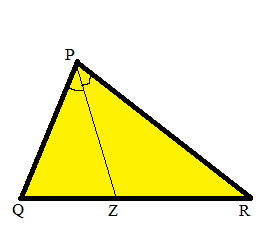In maths, the inequalities on a triangle state that for any triangle, the sum of any two sides of a triangle is greater than the third side. The information prevailed in this article is prepared by the math experts by referring to the textbook. In this article, we are going to solve the problem on inequalities in triangles. Hence, have a look at this page and practice the theorems related to the problem of the triangle inequality.
Triangle Inequality Theorem Proof
Students of 9th grade can find the step-by-step explanation for the problem on inequalities in triangles from here.
Question:
Can you prove the Problem on Inequalities in Triangle?
Given
Let PQR be a triangle in which PZ bisects ∠QPR.
To Prove that:
PQ is greater than QZ (PQ > QZ)
Proof:

As PZ bisects ∠QPR, we have ∠QPR = ∠ZPR……. equation 1
Also, in ∆PZR, ∠PZQ > ∠ZPR, as an exterior angle of a triangle is always greater than either of the interior opposite angles.
Therefore, ∠PZQ > ∠QPZ ……… from equation 1
Therefore, PQ > QZ, as the greater angle has the greater side opposite.
Hence Proved
It is proven that the PQ is greater than QZ.
Also, Check:
- Comparison of Sides and Angles in a Triangle
- Sum of any Two Sides Is greater than Twice the Median
- Sum of the Four Sides of a Quadrilateral Exceeds the Sum of the Diagonals
FAQs on Problem on Inequalities in Triangle
1. What are the inequalities of a triangle?
The 3 properties of the triangle inequality theorem are: If the sum of any two sides is greater than the third, then the difference of any two sides will be less than the third.
2. What is the formula of triangle inequality?
According to the triangle inequality theorem, the sum of any two sides of a triangle is greater than or equal to the third side of a triangle.
3. What is the triangle inequality theorem and why is it important?
The triangle inequality theorem states, The sum of any two sides of a triangle is greater than its third side.